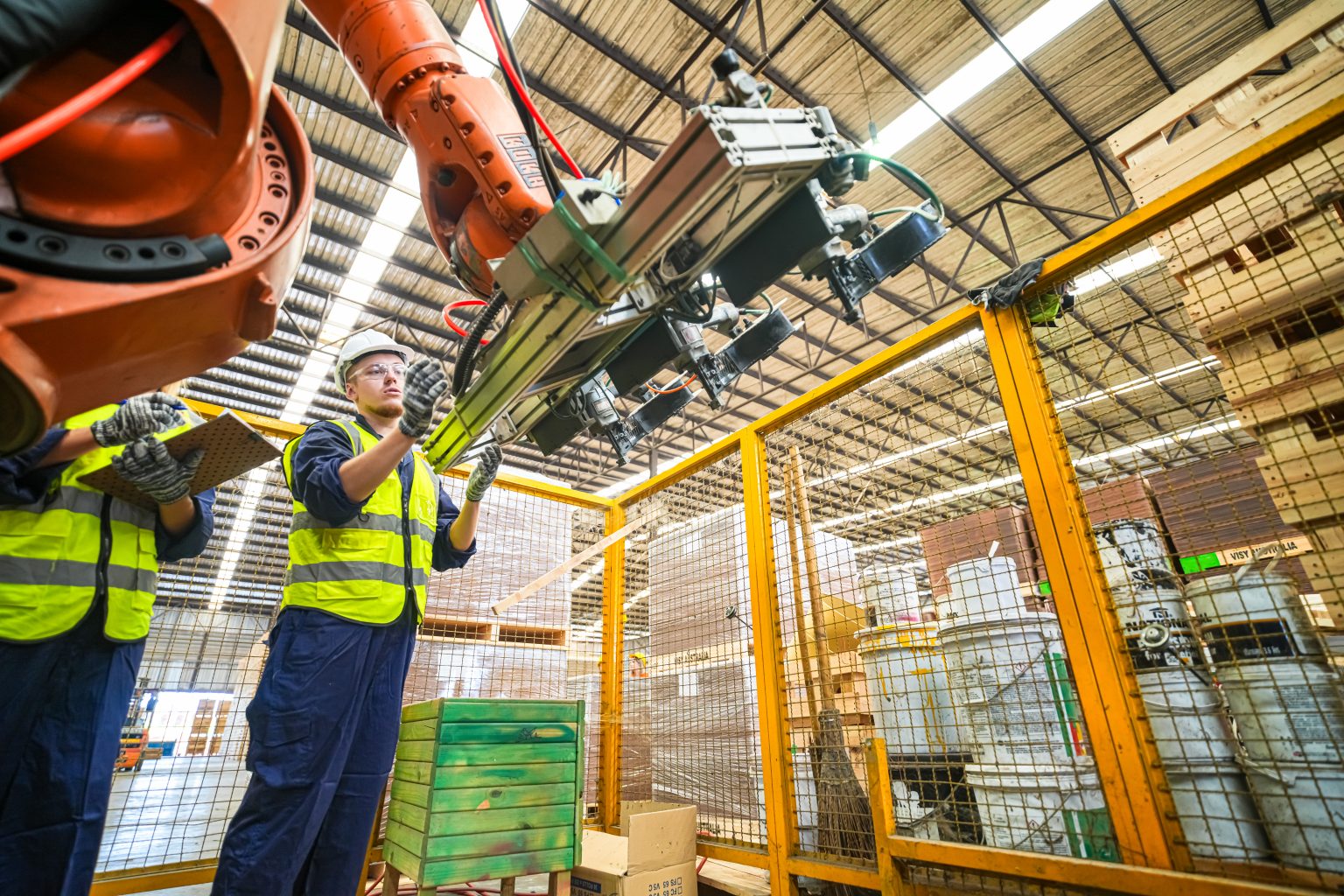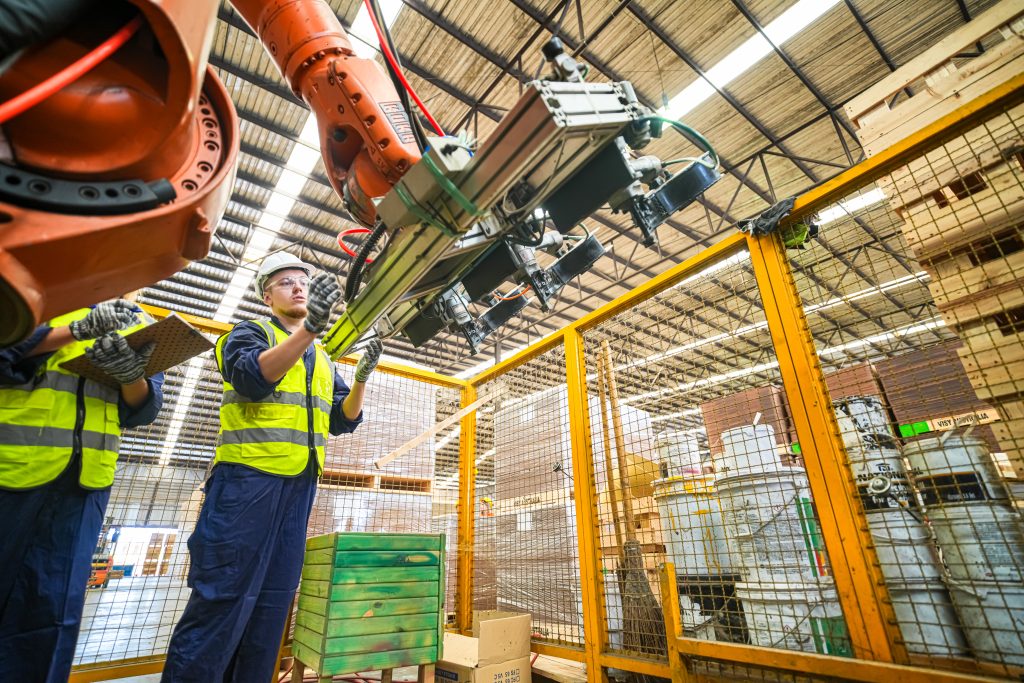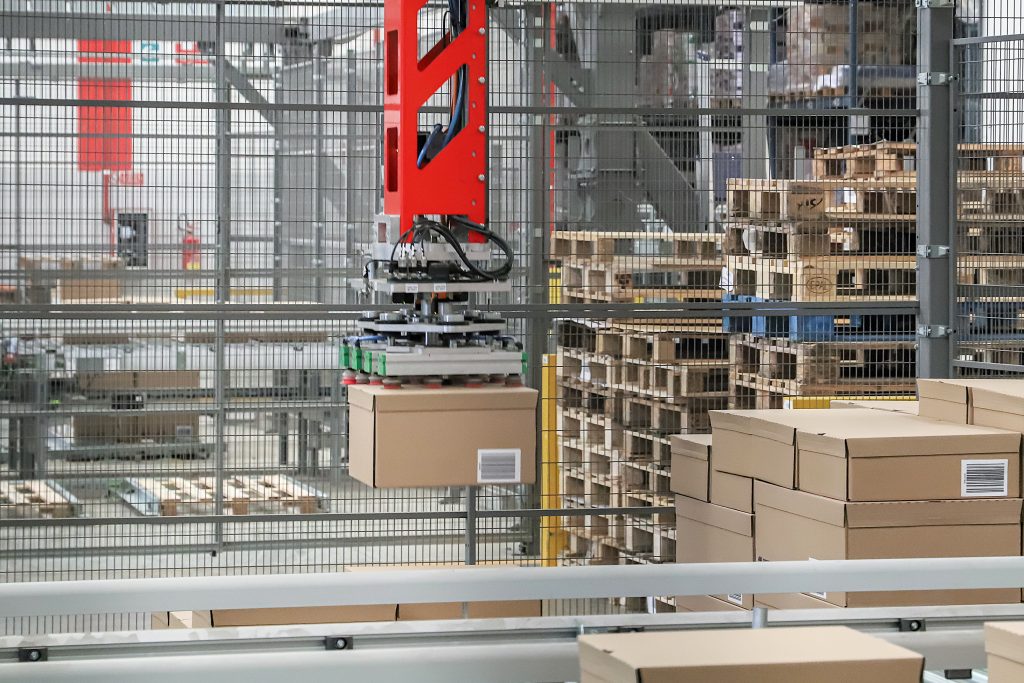In today’s fast-paced industrial landscape, efficient palletizing is crucial for streamlining operations and reducing labor costs. As businesses seek automation solutions, the choice between traditional robot palletizers and collaborative robot (cobot) palletizers becomes pivotal. This article compares the two technologies, with a focus on why cobot palletizers are particularly advantageous for small and medium-sized enterprises (SMEs).
What Is Palletizing?
Palletizing is the process of stacking and securing products onto a pallet, facilitating efficient handling, storage, and transportation. This method consolidates multiple items into a single, stable unit load, streamlining logistics operations across various industries.
In manufacturing, palletizing enhances production flow by allowing seamless movement of goods from assembly lines to storage or shipping areas. Warehousing operations benefit from optimized space utilization, as palletized goods can be stacked vertically, maximizing storage capacity. In the logistics sector, palletization simplifies loading and unloading processes, reducing handling time and minimizing the risk of product damage during transit.
The food and beverage industry relies on palletizing to maintain product integrity and hygiene standards, ensuring that items are securely packaged and protected. E-commerce businesses utilize palletization to manage high volumes of diverse products, enabling efficient order fulfillment and distribution.
Manual Palletizing vs. Robot Palletizer vs. Cobot Palletizer
Manual Palletizing
Manual palletizing involves workers physically stacking products onto pallets—a process that is both labor-intensive and ergonomically challenging. Employees often engage in repetitive motions, such as bending, lifting, and twisting, which can lead to musculoskeletal disorders (MSDs). According to the U.S. Department of Labor, back injuries account for approximately 20% of all workplace injuries, with manual material handling being a significant contributor.
The repetitive nature of manual palletizing not only increases the risk of injuries but also limits operational efficiency. Human workers are prone to fatigue, leading to inconsistent stacking patterns and potential product damage during transit. Moreover, the reliance on manual labor makes it challenging to scale operations in response to increased demand, as hiring and training additional staff can be time-consuming and costly.
In industries where speed, consistency, and safety are paramount, manual palletizing presents significant limitations. The physical strain on workers, combined with the inefficiencies inherent in manual processes, underscores the need for more advanced palletizing solutions. Transitioning to automated systems can mitigate these challenges, enhancing both worker well-being and operational productivity.
Industrial Robot Palletizer
Industrial robot palletizers are engineered for high-speed, heavy-duty tasks, making them indispensable in large-scale production environments. These robotic systems excel in handling substantial payloads with precision and consistency, significantly enhancing throughput and operational efficiency.
While ideal for high-volume operations, industrial robot palletizers are less suited for dynamic or varied workflows. They are particularly effective in industries such as automotive manufacturing, where the handling of heavy and uniform products is routine.
However, the implementation of industrial robot palletizers involves complex setup procedures, including the integration of safety guarding and advanced programming. These systems require substantial initial investment and dedicated space, which can be a barrier for small and medium-sized enterprises (SMEs).
Despite these challenges, the benefits of industrial robot palletizers in suitable applications are significant. They offer unparalleled speed and reliability, reducing labor costs and minimizing the risk of workplace injuries associated with manual palletizing. For businesses with consistent, high-volume palletizing needs, these robotic systems provide a robust and efficient solution.
Cobot Palletizer
Collaborative robot (cobot) palletizers are designed to work safely alongside human operators, offering a flexible and efficient solution for palletizing tasks. Unlike traditional industrial robots, cobots are equipped with advanced sensors and safety features that allow them to operate without extensive safety guarding, making them ideal for environments where space is limited.
One of the key advantages of cobot palletizers is their ease of installation and programming. Many cobots feature intuitive interfaces that enable users with minimal technical expertise to set up and operate the system. This user-friendly approach reduces the time and cost associated with deployment, allowing businesses to quickly adapt to changing production needs.
Cobots are particularly well-suited for low-to-mid-volume tasks in dynamic environments. Their ability to be reprogrammed and redeployed for different tasks or SKUs provides operational flexibility that is essential for small and medium-sized enterprises (SMEs). Additionally, cobot palletizers can operate continuously without breaks, increasing productivity and reducing the physical strain on human workers.
In summary, cobot palletizers offer a cost-effective and adaptable solution for businesses looking to enhance their palletizing processes. Their collaborative nature, ease of use, and flexibility make them an attractive option for SMEs aiming to improve efficiency and maintain a competitive edge in the market.
V2A016 TM Robot – TM Palletizing Operator in Techman Thailand
How Cobots and Robots Improve Palletizing
Integrating robotic and collaborative robotic (cobot) palletizing solutions into business operations can significantly enhance efficiency, scalability, and overall productivity.
Efficient Scalability Without Increasing Headcount
Robotic palletizers operate continuously without fatigue, enabling businesses to scale operations without the need for additional labor. This continuous operation ensures that production can meet increasing demands without compromising on speed or quality.
Boosted Productivity Through Consistent Operation
Cobots maintain a consistent pace, reducing errors and ensuring uniformity in pallet stacking. Their precision minimizes product damage during transit, leading to cost savings and improved customer satisfaction.
Reallocation of Human Resources to Higher-Value Tasks
By automating repetitive and physically demanding tasks, employees can focus on more strategic roles within the organization. This not only enhances job satisfaction but also drives innovation and growth.
Enhanced Workplace Safety
Automating palletizing reduces the risk of workplace injuries associated with manual handling. This leads to a safer work environment and can result in lower insurance premiums and reduced downtime.
Incorporating robotic and cobot palletizing solutions offers a strategic advantage, allowing businesses to optimize operations, reduce costs, and enhance overall efficiency.
Do Small and Medium Businesses Need a Cobot Palletizing System?
For small and medium-sized enterprises (SMEs), integrating a cobot palletizing system offers a strategic advantage in automation without the complexities and costs associated with traditional industrial robots.
Cost-Effective Automation
Cobots present a more affordable entry point into automation. With lower initial investments and reduced integration costs, SMEs can achieve a faster return on investment. Many businesses report recouping their investment within 12 to 18 months, thanks to labor savings and increased productivity.
User-Friendly Interface
Designed with simplicity in mind, cobot systems often feature intuitive interfaces that require minimal training. This ease of use allows existing staff to operate and program the robots without the need for specialized skills, facilitating smoother adoption and operation.
Operational Flexibility
Cobots are inherently adaptable, and capable of handling various tasks and adjusting to different product lines or seasonal demands. Their compact footprint and mobility make them suitable for facilities with limited space, allowing for seamless integration into existing workflows.
Competitive Edge
By automating repetitive and labor-intensive tasks, SMEs can enhance efficiency, reduce reliance on manual labor, and improve overall operational consistency. This not only leads to cost savings but also positions businesses to better meet customer demands and compete effectively in the market.
Investing in a cobot palletizer offers small and medium-sized businesses a flexible, cost-effective automation solution. With quick ROI—often within 12 months—and user-friendly interfaces, cobots enhance productivity without the need for extensive training or infrastructure changes. Their adaptability allows for seamless integration into existing workflows, making them ideal for dynamic production environments. For tailored solutions that fit your business needs, explore Techman Robot’s palletizing options.



